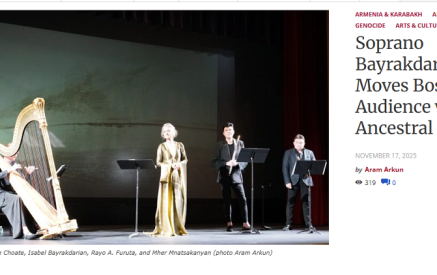by The Armenian Mirror-Spectator
The Alfred Ceramic Art Museum at Alfred University will be host to an exhibit dedicated to sculptor Reuben Nakian through December 30.
Nakian (1897-1986) was born in Queens, NY, to Armenian immigrant parents. As a young man, Nakian could draw. His parents encouraged him. At the age of 12 he discovered New York City’s Metropolitan Museum of Art. Around that same time, he acquired a copy of Bulfinch’s Mythology, originally published in 1867. Greek myth became a touch stone. At 15, Nakian graduated from high school. He took a job in New York determined to find his way to being a professional artist. When he died at the age of 89, the New York Times acclaimed him as “one of the most distinguished American sculptors of the 20th Century” (New York Times obituary, 12/5/86).
Reuben Nakian is best known for his large-scale bronze sculptures. However, Nakian left for posterity a large, highly significant body work in the ceramic medium. It is this less recognized, but unquestionably important work the Alfred Ceramic Art Museum is celebrating with this current exhibition “Reuben Nakian: The Impassioned Gesture.” In a 1981 interview for the Smithsonian’s Archives of American Art speaking of ceramics Nakian remarked: “You don’t have to cast it. When you cast, things are lost. You put it in the kiln, and it has got the thumbprints. They are still there. It is a great medium.” Early in his career Nakian apprenticed with legendary sculptor Paul Manship, perhaps best known for his sculpture, “Prometheus,” at Rockefeller Center, New York City, who modeled with plasteline, a non-drying clay not suitable for firing. Nakian said: “Clay has got life. Plasteline is alright, but it is not life. Clay is the real thing.”

Reuben Nakian, Europa and the Bull, 1980, terracotta, painted patina, 8 ½ x 13 x 4 inches. Collection of the Reuben Nakian estate, photo by Brian Oglesbee
Nakian was a guest of honor at the “Famous Artists’ Evening” at the White House (1966), and the Smithsonian Institution produced a documentary on his life and work titled “Reuben Nakian: Apprentice to the Gods,” (1985). He was awarded a Guggenheim Fellowship in 1931 and a Ford Foundation Fellowship in 1958, and he represented the Unites States as the major sculptor in the VI Biennale in Sao Paulo, Brazil (1961) and the 1968 Biennale in Venice, Italy. Nakian was known best for his monumental sculpture in bronze which are now part of the permanent collections of the Metropolitan Museum of Art; the Museum of Modern Art; the Hirschhorn Museum and Sculpture Garden, Smithsonian Institution; the Buffalo AKG Art Museum, and the Whitney Museum of American Art. The list goes on and on to include 65 leading art museums in the US and internationally.
A word about myth from well-known authority on comparative religion Karen Armstrong. She writes in her 2005 book, A Short History of Myth: “Mythology is not an early attempt at history and does not claim that its tales are objective fact. Like a novel, an opera or a ballet, myth is make believe; it is a game that transfigures our fragmented, tragic world.” In another passage she writes: “Our modern alienation from myth is unprecedented. In the pre-modern world mythology was indispensable. It not only helped people to make sense of their lives but also revealed regions of the human mind that would otherwise have remained in accessible.”
Throughout art history artists have turned to mythology for its fundamental human themes, which serve as a means of philosophical inquiry. The stories of ancient Greek mythological figures have inspired Renaissance masters, modernist painters and sculptors and conceptual artists alike. Imagine Reuben Nakian as a young want-to-be artist avidly reading his copy of Bulfinch’s Mythology one day and visiting the Metropolitan Museum of Art the next to see these myths come to life in paintings by legendary artists. For Nakian an indelible impression gave birth to a lifetime of creativity.
Wayne Higby, director and principal curator at Alfred Ceramic Art Museum, said, “The vigorous and eloquent gesture so remarkably manifest in Reuben Nakian’s ceramic work begins with drawing, the matrix of his emergence as a world-class artist. Gesture became Nakian’s signature transferred to the immediacy of the ink brush and to the tool and the clay. His understanding of the clay is perceptive. Timing is the essence of working in clay. Clay is often too wet, too soft, too dry, too hard. Knowing exactly when to make a move is a twofold gift of empathy and experience. Reuben Nakian’s art resonates with enlightened intuition arising from a merging of his vitality and the material at hand. This is most constant, personal, and substantially evident in his ceramic work.”

Reuben Nakian, Dancer, 1983, terracotta, white and pink paint, 11 ½ x7 ¾ x 4 inches.
Collection of the Reuben Nakian estate, photo by Brian Oglesbee
Curator Anne Currier added, “The ceramic and bronze sculptures selected for the exhibition, “Reuben Nakian: The Impassioned Gesture,” conjure parallel links to 18th-century porcelain figurines. The similarity of their dimensions and small scale insinuates their presence within a domestic space, conducive to discovering the lyricism and diversity of their figural compositions and narrative allusions. Nakian’s ceramic sculptures reveal the agility of his hands working in wet clay. Using only his fingers and a few tools, primarily a knife, Nakian reconciles representation and abstraction. Transitions of incised lines, pinched surfaces, rolled coils, masses and voids, pokes and punches reveal the audacity and fluency of his touch to capture the essence of a fleeting moment. The choreographic dynamism of Reuben Nakian’s small sculptures and ink drawings transcend generations and styles, affirming the rhythmic grammar of gesture and its power to delight.”

























































